Originally posted on December 21, 2023 @ 1:40 am
If you’re a fan of Mexican cuisine, you’re probably familiar with the rich and smoky flavor of cascabel peppers. These dried peppers add a unique nutty and earthy taste to dishes like salsas, soups, and stews. However, finding cascabel peppers can be a challenge, especially if you don’t have access to specialty stores or markets.
But don’t worry! There are several alternatives you can use as a substitute for cascabel peppers. In this article, we’ll explore different options that can help you achieve similar flavors and spice levels in your recipes.
Table of Contents
Key Takeaways:
- When substituting cascabel peppers, consider alternatives like cascabel powder, cascabel chili paste, guajillo chiles, pasilla chiles, and puya chiles.
- Guajillo chiles offer a similar taste profile with a fruity flavor, while puya chiles provide a hotter and spicier substitute.
- Cascabel powder can be used as a substitute for whole cascabel peppers, but adjust the quantity as it may intensify the flavor and heat.
- Experiment with other substitutes like arbol chiles, California chiles, Mulato peppers, and chipotle Chile pepper if you can’t find the recommended options.
- Cascabel chiles are versatile and can be used in a variety of dishes, including sauces, stews, casseroles, and marinades.
Cascabel Pepper Alternatives
When you can’t find cascabel peppers for your recipes, don’t worry! There are several great alternatives that can still give you that unique flavor you’re looking for. Here are some of the best substitutes for cascabel peppers:
- Cascabel powder: Made from ground cascabel peppers, cascabel powder provides the same nutty, earthy, and smoky flavors as the whole peppers.
- Cascabel chili paste: This paste is created by hydrating and blending cascabel peppers, making it an excellent substitute that retains the distinctive cascabel flavor.
- Guajillo chiles: With their fruity undertones, guajillo chiles offer a similar taste profile to cascabel peppers, making them a fantastic alternative.
- Pasilla chiles: If you prefer milder heat, pasilla chiles are a great substitute. They bring a rich, smoky flavor without the same level of spiciness as cascabel peppers.
- Puya chiles: Looking for something hotter? Puya chiles can provide the heat you desire as a substitute for cascabel peppers. They also offer a slightly fruity flavor to complement your dishes.
Experiment with these alternatives and see which one suits your taste preferences and the specific recipe you’re cooking. Whether you choose cascabel powder, cascabel chili paste, guajillo chiles, pasilla chiles, or puya chiles, you can still enjoy the unique flavors of cascabel peppers in your favorite dishes.
Using Cascabel Powder
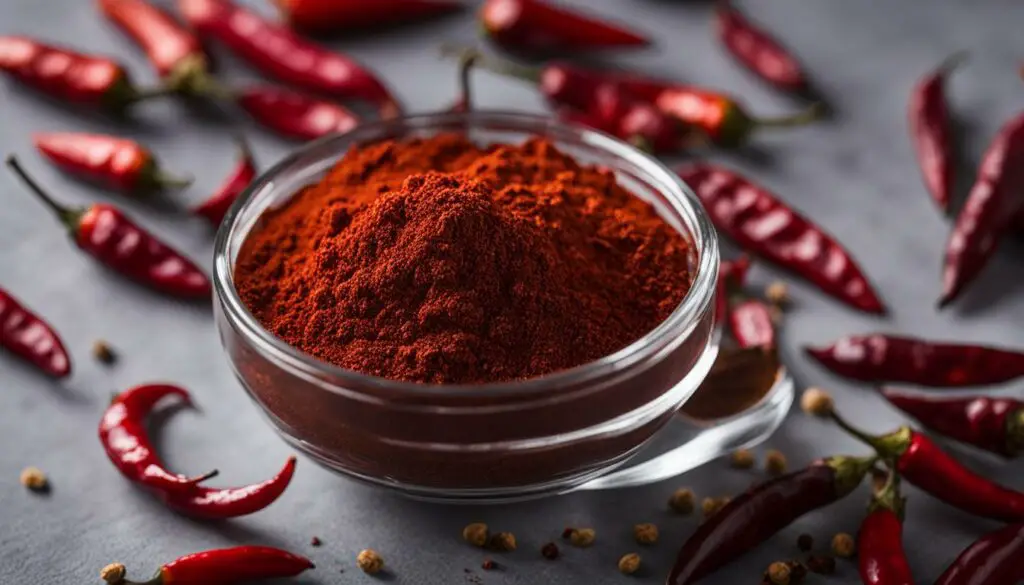
If you have access to cascabel powder, it can be a convenient substitute for whole cascabel peppers in your recipes. The powder retains the distinctive flavor and spiciness of the peppers, making it an excellent option for those who are unable to find the fresh peppers. However, it’s essential to remember that the powder is more concentrated, so you may need to use less of it compared to the whole peppers. This way, you can achieve the desired level of flavor and heat without overpowering your dishes.
To use cascabel powder, simply replace the fresh peppers with an appropriate amount of powder based on your taste preferences. Start by using half the amount of powder compared to the whole peppers, and adjust accordingly based on your preference for spice. Remember, it’s always easier to add more if needed, but difficult to reduce the intensity once it’s incorporated into the dish.
One advantage of using cascabel powder is that it offers more convenience and a longer shelf life compared to whole peppers. The powder can be easily stored in a cool, dry place, ensuring its freshness for an extended period. This means that you can always have the option of using cascabel powder as a substitute whenever the fresh peppers are not available.
| Cascabel Powder as a Substitute for Whole Cascabel Peppers | Advantages | Disadvantages |
|---|---|---|
| Retains the flavor and spiciness of cascabel peppers | Convenient and easy to store | May need to use less due to its concentration |
| Provides a longer shelf life compared to fresh peppers |
Tip:
When using cascabel powder as a substitute, start with a smaller amount and gradually increase according to your desired level of spiciness. This way, you can maintain control over the heat in your dishes and ensure an enjoyable dining experience.
Using Cascabel Chili Paste
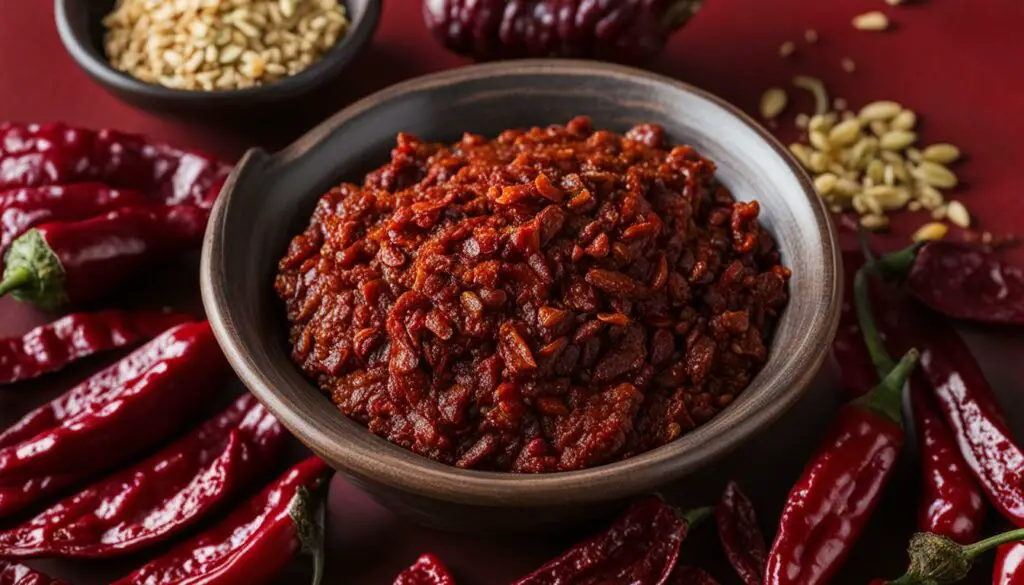
If you’re unable to find whole cascabel peppers, another fantastic alternative is cascabel chili paste, also known as cascabel puree. This flavorful paste can be used in various recipes to add depth and heat. You have two options when it comes to obtaining cascabel chili paste: making your own or purchasing it pre-made.
Making your own cascabel chili paste is a rewarding process that allows you to control the ingredients and adjust the flavor according to your taste preferences. Begin by hydrating dried cascabel chiles in warm water for approximately 20 minutes, until they become soft and pliable. Remove the stems and seeds, then transfer the chiles to a blender or food processor. Blend until you achieve a smooth and thick consistency, similar to a paste. If necessary, add a small amount of warm water to aid the blending process. Once blended, your homemade cascabel chili paste is ready to use.
If time is of the essence, don’t fret! You can easily find pre-made cascabel chili paste in well-stocked supermarkets or specialty stores. Simply check the international or Mexican aisle for this flavorful ingredient. It typically comes in jars or tubes and can be stored in the refrigerator for future use.
Guajillo Chiles as a Substitute
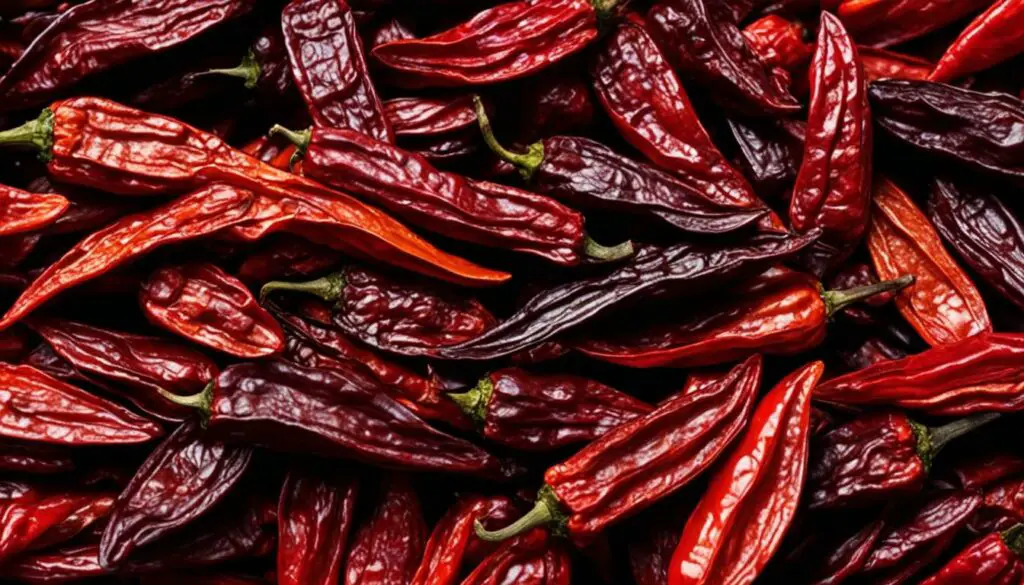
When it comes to finding a substitute for cascabel peppers, guajillo chiles are an excellent option. These chiles offer a similar taste profile, making them a suitable replacement in various recipes. Whether you want to simmer, puree, or incorporate them into marinades and spice rubs, guajillo chiles can help you recreate the smoky and spicy flavors that cascabel peppers provide.
You can easily find guajillo chiles in Mexican or Latin grocery stores, and they are available in both dried and powdered forms. Their versatility and availability make them a convenient choice for anyone seeking an alternative to cascabel peppers.
To give you a better idea of the qualities of guajillo chiles, here’s a brief comparison:
| Cascabel Peppers | Guajillo Chiles |
|---|---|
| Medium level of spiciness | Medium level of spiciness |
| Nutty, earthy, and smoky flavor | Similar flavor profile with a fruity taste |
| Known for their round shape and reddish-brown color | Long, slender shape with a dark red color |
As shown above, guajillo chiles can seamlessly replace cascabel peppers thanks to their similar heat level and flavor. Their fruity taste adds a unique twist to your dishes, ensuring a satisfying culinary experience.
How to Use Guajillo Chiles
There are numerous ways to incorporate guajillo chiles into your recipes. Here are a few suggestions:
- Add dried guajillo chiles to simmering sauces or stews for a deep and rich flavor.
- Puree rehydrated guajillo chiles to create a flavorful paste that can be used as a base for marinades or as an ingredient in meat rubs.
- Grind dried guajillo chiles into a powder and sprinkle it onto roasted vegetables or grilled meats for an added kick.
Next time you’re in need of a cascabel pepper substitute, give guajillo chiles a try. Their availability, similar flavor profile, and medium heat level make them an ideal choice for recreating the delicious flavors that cascabel peppers bring to your recipes.
Puya Chiles as a Substitute
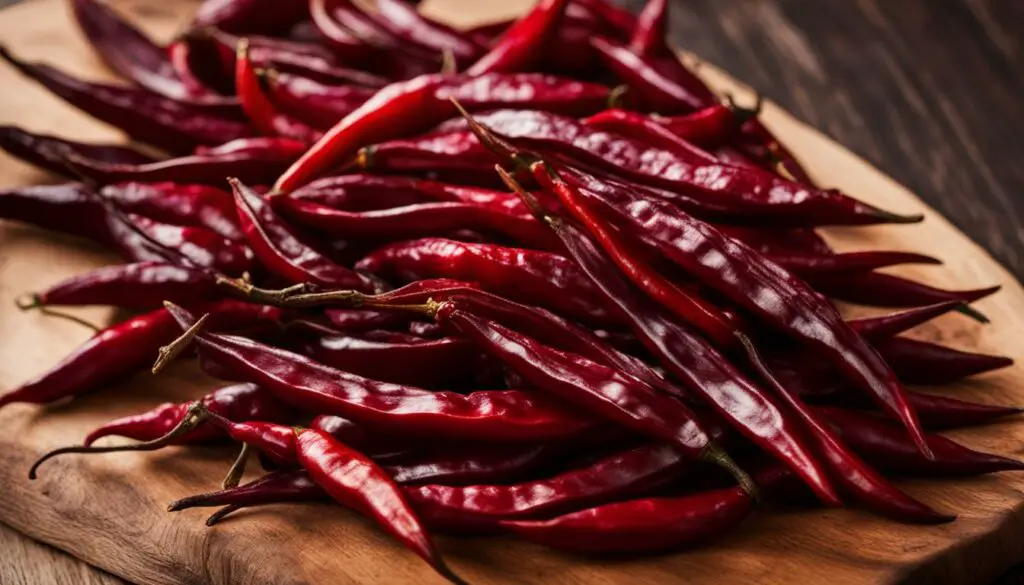
If you’re a fan of spicier dishes and looking for a substitute for cascabel peppers, puya chiles are an excellent choice. These chiles pack a hotter punch than cascabel peppers, adding an extra kick to your recipes. With their fruity flavor and versatility, puya chiles can elevate your culinary creations.
Whether used in their mashed or pureed form, puya chiles deliver a unique taste experience. Their spiciness and fruity undertones blend well with various ingredients, making them a great choice for toppings, fish dishes, and pork recipes.
Incorporating puya chiles into your cooking allows you to experiment with different levels of heat, enhancing the flavor profiles of your favorite dishes. From spicy salsas to aromatic stews, these versatile chiles can take your culinary creations to the next level.
Benefits of Using Puya Chiles:
- Hotter than cascabel peppers, adding a fiery kick to your recipes
- Fruity flavor that complements a wide range of ingredients
- Can be used in mashed or pureed form for different recipe applications
- Perfect for toppings, fish dishes, and pork recipes
- Allows for experimentation with spice levels to suit your taste preferences
Replace cascabel peppers with puya chiles when you’re in the mood for a spicier flavor profile. Just remember to adjust the quantities according to your desired level of heat. Whether you’re a spice lover or looking to add some extra kick to your dishes, puya chiles won’t disappoint.
Using Arbol Chiles as a Substitute
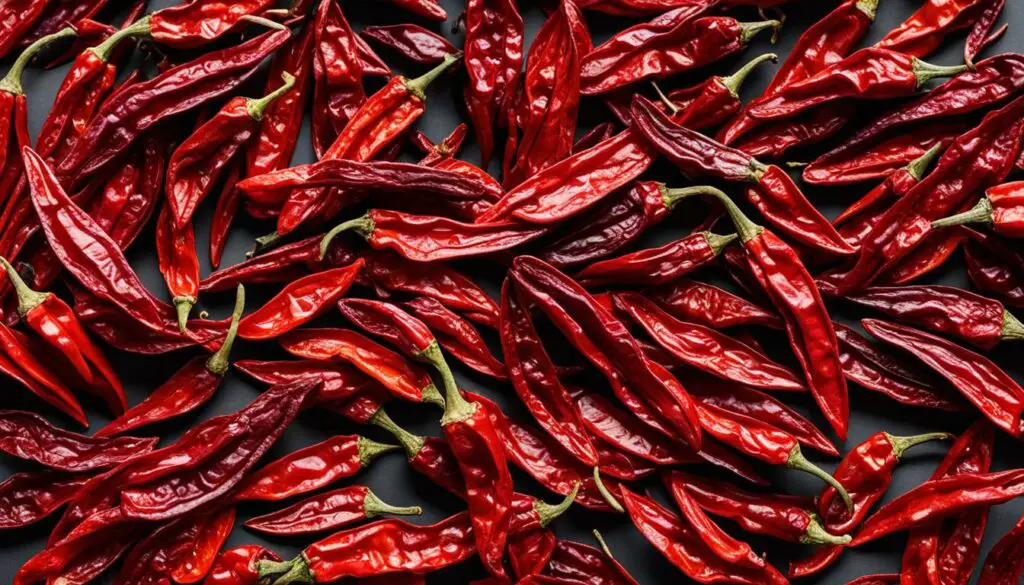
If you’re unable to find cascabel peppers, don’t worry! Arbol chiles can be a fantastic substitute. These fiery chiles are known for their intense heat and vibrant flavor, making them a popular choice in Mexican cuisine.
Arbol chiles are incredibly versatile and can be used in various dishes. Here are some great ways to incorporate them into your cooking:
- Add whole arbol chiles to soups and stews for a spicy kick.
- Grind dried arbol chiles into a powder and use it as a seasoning for marinades and rubs.
- Make a homemade salsa with blended arbol chiles, tomatoes, onions, and garlic.
- Toss some chopped arbol chiles into salads to add a fiery punch.
Remember, arbol chiles pack heat, so use them sparingly if you prefer milder flavors. They are available in dried, fresh, or powdered form, depending on your preference and convenience.
Arbol Chiles and Scoville Heat Units (SHU)
Arbol chiles fall within a similar heat range as cascabel peppers, with an approximate Scoville Heat Units (SHU) ranging from 15,000 to 30,000. They are significantly hotter than jalapenos but milder than some of the super-hot chiles like habaneros or Carolina Reapers.
Here’s a comparison of the heat levels of various chiles:
| Chile | Scoville Heat Units (SHU) |
|---|---|
| Arbol Chiles | 15,000-30,000 |
| Cascabel Peppers | 1,300-2,000 |
| Jalapenos | 2,500-8,000 |
| Habanero Chiles | 100,000-350,000 |
| Carolina Reaper | 1,400,000-2,200,000 |
As you can see, arbol chiles provide a significant amount of heat, similar to cascabel peppers but not as intense as the hottest chiles available.
Now that you know how to use arbol chiles as a substitute, embrace their fiery flavor and experiment with them in your favorite recipes!
Other Substitutes for Cascabel Peppers
If you are unable to find any of the previously mentioned substitutes, you can consider using California chiles, Mulato peppers, chipotle Chile pepper, or dried New Mexico peppers. These peppers may have slightly different flavors and heat levels, but they can still be used as alternatives to cascabel peppers.
Best Uses for Cascabel Chiles
Cascabel chiles are a versatile ingredient that can add a smoky and nutty flavor to a variety of dishes. Here are some of the best uses for cooking with cascabel chiles:
Sauces:
Cascabel chiles are commonly used in sauces to enhance their flavor and add a mild spiciness. Whether you’re making a traditional Mexican mole sauce or a simple enchilada sauce, cascabel chiles can elevate the taste and complexity of your dish.
Salsas:
If you enjoy adding a kick of heat and flavor to your salsas, cascabel chiles are a great choice. They can be used in both fresh salsas and cooked salsas, giving them a unique smoky undertone that pairs well with tomatoes, onions, and cilantro.
Soups and Stews:
Cascabel chiles can be added to soups and stews to infuse them with a deep and rich flavor. Whether you’re making a hearty chili or a comforting chicken tortilla soup, the smoky and nutty notes of cascabel chiles will create a delicious and satisfying dish.
Casseroles:
Incorporating cascabel chiles into casseroles can add a delightful layer of flavor. Whether you’re making a Mexican-inspired casserole with layers of tortillas, cheese, and meat, or a comforting baked pasta dish, the smoky and nutty profile of cascabel chiles will take your casserole to the next level.
Enchiladas:
Cascabel chiles are a popular choice for making enchilada sauce from scratch. The combination of their smokiness and mild heat adds depth and complexity to the sauce, resulting in flavorful and authentic enchiladas. You can also stuff enchiladas with a filling that includes cascabel chiles for an extra burst of flavor.
Fajitas:
When cooking fajitas, you can use cascabel chiles to add a unique flavor to the marinade. The smoky and nutty notes of the chiles complement the grilled meats and vegetables, creating a delicious and aromatic filling for your fajitas.
Tacos:
For taco lovers, cascabel chiles can be a game-changer. They can be used to season the meat fillings, giving them a smoky undertone that pairs perfectly with the traditional taco toppings. Whether you’re making carne asada tacos or vegetarian options, cascabel chiles can add a new dimension of flavor to your tacos.
Marinades and Rubs:
Cascabel chiles can be ground into a powder or used in their whole form to create flavorful marinades and spice rubs. Whether you’re marinating chicken, beef, or seafood, or preparing a dry rub for grilling or roasting, cascabel chiles will add a smoky and nutty kick that will elevate your dishes.
With their unique flavor profile, cascabel chiles can enhance a wide range of dishes and recipes. Whether you’re a fan of spicy or milder flavors, cooking with cascabel chiles can add a touch of Mexican-inspired goodness to your meals. Experiment with these versatile chiles and discover new and exciting ways to incorporate them into your cooking.
Conclusion
In conclusion, if you’re unable to find cascabel peppers, don’t worry! There are plenty of substitutes available that can still bring the spicy and smoky flavors to your recipes. Whether you opt for cascabel powder, guajillo chiles, or puya chiles, each alternative offers its own unique taste profile to enhance your dishes.
Experimenting with different substitutes can be an exciting culinary journey, allowing you to discover new flavor combinations and tailor your recipes to suit your taste preferences. Whether you’re making sauces, salsas, or marinating meats, there’s a substitute that will provide the desired level of heat and depth of flavor.
So, the next time you’re unable to find cascabel peppers, remember that there’s no need to compromise on taste. Embrace the versatility of these substitutes and let your creativity shine in the kitchen. Happy cooking!
FAQ
What are some good substitutes for cascabel peppers?
Some of the best substitutes for cascabel peppers include cascabel powder, cascabel chili paste, guajillo chiles, pasilla chiles, and puya chiles. Other options include California chiles, Mulato peppers, chipotle Chile pepper, or dried New Mexico peppers.
Can I use cascabel powder instead of whole cascabel peppers?
Yes, cascabel powder can be used as a substitute for whole cascabel peppers. However, keep in mind that the powder will enhance the flavor and spiciness, so you may need to use less than you would with whole peppers.
How can I use cascabel chili paste as a substitute?
Cascabel chili paste, also known as cascabel puree, can be used as a substitute for whole cascabel peppers. You can make your own paste by hydrating and blending cascabel chiles, or you can find it pre-made in supermarkets. The cascabel chili paste can be stored in jars in the refrigerator for future use.
What is a good alternative to cascabel peppers with a similar taste profile?
Guajillo chiles are a good substitute for cascabel peppers as they offer a similar taste profile. You can simmer, puree, or use guajillo chiles in marinades, spice rubs, and other recipes that call for cascabel peppers.
Are there any substitutes for cascabel peppers that are hotter?
Puya chiles are hotter than cascabel peppers but can be used as a substitute if you enjoy spicier dishes. They have a fruity flavor and can be used in their mashed or pureed form.
Can I use arbol chiles as a substitute for cascabel peppers?
Yes, arbol chiles are another option if you can’t find cascabel peppers. They are hot and can be used in soups, stews, marinades, and salads.
Are there any other substitutes for cascabel peppers?
If you can’t find cascabel peppers or any of the previously mentioned substitutes, you can consider using California chiles, Mulato peppers, chipotle Chile pepper, or dried New Mexico peppers. These peppers may have slightly different flavors and heat levels, but they can still be used as alternatives to cascabel peppers.
What are the best uses for cascabel chiles?
Cascabel chiles are commonly used in sauces, salsas, soups, stews, casseroles, enchiladas, fajitas, and even tacos. They provide a smoky and nutty flavor to dishes and can also be used in marinades and stuffing for fish and meats.
Source Links
- https://brokebankvegan.com/chile-cascabel/
- https://www.diversivore.com/the-pantry/cascabel-chilies/
- https://foodiesfamily.com/cascabel-chile-substitutes/
See also:
Leave a Reply